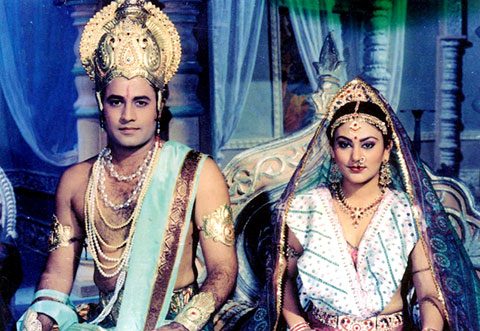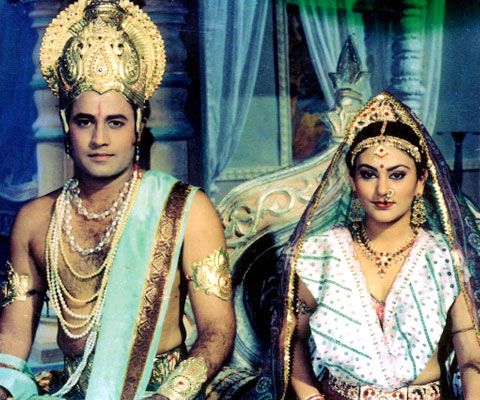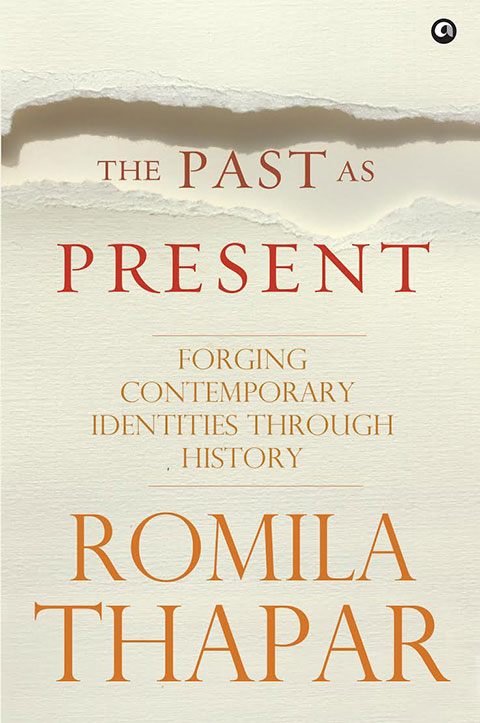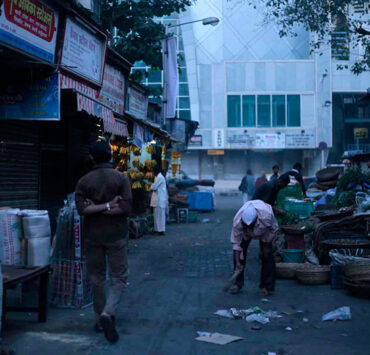The opinions that were gathered by newspapers when Ramanand Sagar’s T.V. serial on the Ramayana ended revealed what an extraordinary media success it had been. The show’s popularity reached out across religions, castes, occupations, and languages.
Was this because it was an emotion-filled story narrated in the style of T.V. serials; or the enactment of a religious belief in a new idiom associated with modern life? Is there an intrinsic attraction in fantasies on good vs. evil that have a particular appeal if they claim to represent past times? It was stated that its popularity resulted from its being a part of the collective unconscious; that among adults it evoked memories of childhood stories and among children it paralleled the exploits of a hero like Superman; that it was an embodiment of higher values and laid out the quest for dharma in a simple, narrative form; that it projected the ideal woman in Sita; that it appeased the apprehensions and insecurities of a society transitioning to modernity; that it gave visual form to the spiritual fountainhead of Hinduism. Those who were unhappy with the rendering complained of the absence of poetry and meaning. It was also described as a folk genre, a small-town Ram-leela that managed to hit the big lights by being broadcast on television.

Ramanand Sagar’s Ramayana reached out across religions, castes, occupations, and languages.
Only a few seemed concerned about the long-term effects of such a serial. Were we perhaps witnessing an attempt to project what the new culture of the country should be, an attempt to expunge diversities and present a homogenised view of what the Ramayana was and is? Could the serial be seen as part of an increasing trend of treating the state as the arch patron of culture, of state patronage requiring a uniform culture with the state determining the manifestations of culture, whether it be the festivals, the media or the aims behind the cultural zones? The state defines culture, finances culture, is the final arbiter and as the patron bestows recognition on those whom it regards as creative and worthy. Private initiative cannot compete with the financial outlay and the public reach that the state can provide, and there is not enough public initiative to provide alternate avenues to support innovatory forms. Would private initiative support innovation or would it encourage the conventional and the conservative?
The state prefers to endorse a uniform, homogenised culture, as such a culture would be simple to identify and easy to control. To concede that a nation’s culture may be constituted of a variety of cultural systems would require that the functionaries of the state be sensitive to these multiple cultural systems and respond to their political implications. Where culture is taken over by the state as the major patron, there the politics of culture is inevitably heightened. It is therefore often easier for the state as patron to adopt a particular cultural stream as the mainstream: a cultural hegemony that frequently coincides with the culture of the dominant social group.
Some would see this new extension of patronage by the state as legitimate, for the state is now expected to provide for everything. But others would see this as a threat to creativity. The relationship between the patron and the one who creates is delicate, where, although the patron controls finance and recognition, the patron is at best merely the agency for the act of creativity. In earlier times acts of creativity had an audience but could do without a patron, although the more elaborate arts and literature required a patron. That creativity today is far more dependent on patronage, requiring the patron to be particularly careful about the representation of culture, particularly where culture is being represented through the authoritative state-controlled media. I would like to illustrate this by reference to the Ramayana.
The Ramayana does not belong to any one moment in history for it has its own history which lies embedded in the many versions which were woven around the theme at different times and places, even within its own history in the Indian subcontinent. The Indian epics were never frozen as were the compositions of Homer when they changed from an oral to a literate form. Professional reciters, kathakaras, recited the written versions with their own commentary and frequently adjusted the story to contemporary norms. The appropriation of the story by a multiplicity of groups meant a multiplicity of versions through which the social aspirations and ideological concerns of each group were articulated. The story in these versions included significant variations that changed the conceptualisation of character, event, and meaning.
Even within the literate tradition there are substantial differences. Scholars working on the Ramayana argue that the now non-existent original ramakatha was perhaps worked over and added to by Valmiki. This version may then have been changed by the Bhargava brahmana redactors who introduced the concept of Rama being an avatara of Vishnu, thus transforming the epic into sacred literature, a transformation that in the past captured popular literature for didactic purposes. Parallel to this was the Buddhist rendering in some of the Jatakas, whereas in the Dasaratha Jataka, Sita is the sister of Rama which change in the kinship pattern is reflected in Buddhist origin myths and carries its own meaning.
A Jaina version, the Paumacharyam, claims to be the sole authentic version of the story and maintains this unequivocally.The treatment of Ravana in this text is much more sympathetic. Lanka is as important if not more so than Ayodhya and the events are coloured by Jaina ethics. Thus Dasharatha and Rama end up as Jaina munis and Sita gets herself to a nunnery. The earliest Tamil version by Kampan changes the treatment of Ravana who is here the tragic hero rather than the villainous demon. The religious importance of the story increased in the early second millennium A.D. with the spread of the Ramanandin sect that worshipped Vishnu in his incarnation as Rama and their most popular sacred literature was the sixteenth century work of Tulasidasa, the Ramacharitamanas.
Even within the literate tradition, the significance of these variations is not ignored. The differences highlight the varying perceptions of many aspects of the story, more than are underlined in any one of the various versions, such as notions of ethical behaviour, whether it be the ideal of the kshatriya in the brahmanical version or the ideal of the Jaina ascetic in the Paumacharyam; or the idea of historicity, where the Jaina version claims it, but the brahmanical one ignores it; or of the depiction of Ravana as the personification of evil or as a tragic hero; or of the embodiment of women where the role of Sita varies.These were not simply variations in the story to add flavour to the narrative. They were conscious attempts at taking up a well-known theme and using it to present a new point of view arising out of ideological and social differences of perspective.
These were acts of deliberate innovation, where the creator of the form felt free to experiment with the story even after the story had been given a sacred character by brahmana redactors. These variants were not hidden in some obscure treatise. They took the form of popular narratives, recited and written in Pali and Prakrit and later in regional languages, and therefore available to large numbers of people. If we are to be aware of at least this strand of our cultural tradition then the debate and the dialectic embedded in these various versions should be more openly discussed.
What would happen today if an attempt were made to project on T.V. a different version of the story? It is likely that Doordarshan or any other channel would not allow it, arguing that it would hurt the religious sensibilities of the majority community. Even if an attempt were to be made to perform it only as a play, the self-appointed guardians of Hinduism, such as the Shiv Sena, V.H.P., R.S.S., Bajrang Dal, and similar organisations, would prevent its being staged. The assault of the Shiv Sena on a theatre in Bombay and the beating up of the playwright, where a play was to be performed on the interlocking theme of Rama and Sita and Romeo and Juliet, is an indication of what would happen. Unfortunately, public protest has been too ineffectual to counteract such attitudes. But if the state or whomsoever else claims to be the major patron of culture, such incidents require at least a statement from the patron.
If the state as the main patron of culture withdraws from innovations in creativity on the grounds that it will hurt the sentiments of a ‘religious community’, culture will tend to be reduced to the lowest common denominator. The interface between religion, politics, and culture becomes a central issue in this situation. Religious sects of various beliefs in India—Hindu, Muslim, Sikh, Christian, Animist—are characterised by a relative absence of the equivalent of the fiat from the Vatican. Who then speaks for that nebulous mass which is referred to as a ‘religious community’? Those that force the issue on the state taking action on cultural or intellectual items are not always the religious functionaries of a community, but often the political spokesmen of some group claiming to represent a religious community.
Thus the Shiv Sena can once again object to the government of Maharashtra reprinting a chapter of Dr. Ambedkar’s book because it questions the authenticity of the brahmanical version of the Ramayana among other things, and the government bends. It may not even be a question of objecting to the suppression of the views of Ambedkar per se, but of allowing various readings of a cultural tradition. Or another person demands the banning of Salman Rushdie’s book The Satanic Verses, and again the government accedes to this demand. Predictably the next step is that the government anticipates a demand from some Christian groups to ban The Last Temptation of Christ and yet once more it caves in under pressure and bans the film. Are we going to be left then with laundered strips of culture because the patron, the state or whatever the agency of authority cannot distinguish between claims to religious sensibilities and cultural articulation?
A statement repeated ad nauseum is that of tolerance being a valued characteristic of Indian civilisation. There has been little attempt to analyse the nature of this tolerance. It assumed a segmented society in which each caste functioned in accordance with its own dharma and the totality was juxtaposed and co-existed. Intolerance was effective within each caste but by and large other castes were left alone to do and believe as they pleased. All, of course, except those that were treated as outside castes—those whom we now call tribals and Dalits. They had a permanent rank at the bottom. Polemics were in fact an essential part of ideology and belief. Now that we are moving away from a segmented society, we have to consciously acquire a concern for tolerance that includes the entire society. We can retain tolerance only if we refrain from rushing to censorship of all kinds.
Tolerance does not grow with banning what is thought to be unpalatable; it grows with arguing and talking about it; for that which is unpalatable gets discarded. Before a book or a film or an exhibition is banned there should at least be a debate about why it is necessary to do so. There was no attempt to discuss what had actually been said in The Satanic Verses and the issues involved. Those who demanded the ban blatantly stated that they had not read the book. Those who rushed to ban it had not read it either. To demand the immediate banning of the book was shrewd as it also pre-empted any discussion, even among Muslims, on the issues raised in the book. Such a discussion might have revealed differences of opinion, differences indicating that not every Indian wanted the book banned and there were many that wanted it discussed to ascertain what exactly was being attacked in the book. And such discussions are imperative even for those who have a strong religious identity of any kind, if, as a society, we are to break the siege of communalism.
(Excerpted with the permission of Aleph Book Company, from The Past as Present by Romila Thapar. Click here to purchase.)









